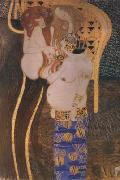
Oil On
Canvas, Real Flavor of Old Masters
|
Gustav Klimt
|
|||
|
|
|||
| Austrian Art Nouveau Painter, 1862-1918 Gustav Klimt (July 14, 1862 ?C February 6, 1918) was an Austrian Symbolist painter and one of the most prominent members of the Vienna Art Nouveau (Vienna Secession) movement. His major works include paintings, murals, sketches, and other art objects, many of which are on display in the Vienna Secession gallery. Klimt's primary subject was the female body, and his works are marked by a frank eroticism--nowhere is this more apparent than in his numerous drawings in pencil. Klimt's work is distinguished by the elegant gold or coloured decoration, often of a phallic shape that conceals the more erotic positions of the drawings upon which many of his paintings are based. This can be seen in Judith I (1901), and in The Kiss (1907?C1908), and especially in Danaë (1907). One of the most common themes Klimt utilized was that of the dominant woman, the femme fatale. Art historians note an eclectic range of influences contributing to Klimt's distinct style, including Egyptian, Minoan, Classical Greek, and Byzantine inspirations. Klimt was also inspired by the engravings of Albrecht D??rer, late medieval European painting, and Japanese Rimpa school. His mature works are characterized by a rejection of earlier naturalistic styles, and make use of symbols or symbolic elements to convey psychological ideas and emphasize the "freedom" of art from traditional culture. | |||
|
|
|||
|
|
Beethoven Frieze (mk20) new7/Gustav Klimt-935454.jpg Painting ID:: 22428 Visit European Gallery |
1902 Beethoven-Fries Central narrow wall(Detail):Unchastity,Lust and Gluttony Unkeuschheit,Wollust und Unmassigkeit Casein paint on plaster,220 cmhigh Austrian Gallery,Vienna | |
Height Width |
INS/CM |
||
|
X |
|
||
|
|
|||
|
Gustav Klimt
|
|||
|
|
|||
| Austrian Art Nouveau Painter, 1862-1918 Gustav Klimt (July 14, 1862 ?C February 6, 1918) was an Austrian Symbolist painter and one of the most prominent members of the Vienna Art Nouveau (Vienna Secession) movement. His major works include paintings, murals, sketches, and other art objects, many of which are on display in the Vienna Secession gallery. Klimt's primary subject was the female body, and his works are marked by a frank eroticism--nowhere is this more apparent than in his numerous drawings in pencil. Klimt's work is distinguished by the elegant gold or coloured decoration, often of a phallic shape that conceals the more erotic positions of the drawings upon which many of his paintings are based. This can be seen in Judith I (1901), and in The Kiss (1907?C1908), and especially in Danaë (1907). One of the most common themes Klimt utilized was that of the dominant woman, the femme fatale. Art historians note an eclectic range of influences contributing to Klimt's distinct style, including Egyptian, Minoan, Classical Greek, and Byzantine inspirations. Klimt was also inspired by the engravings of Albrecht D??rer, late medieval European painting, and Japanese Rimpa school. His mature works are characterized by a rejection of earlier naturalistic styles, and make use of symbols or symbolic elements to convey psychological ideas and emphasize the "freedom" of art from traditional culture. | |||
|
|
|||
|
|
Beethoven Frieze (mk20) new7/Gustav Klimt-424446.jpg Painting ID:: 22430 Visit European Gallery |
1902 Central end wall(detail):Hostile Forces Die Feindlichen Gewalten Casein paint on plaster,2.2 metres high,6.36 metres long Autrian Gallery,Vienna | |
Height Width |
INS/CM |
||
|
X |
|
||
|
|
|||
|
Gustav Klimt
|
|||
|
|
|||
| Austrian Art Nouveau Painter, 1862-1918 Gustav Klimt (July 14, 1862 ?C February 6, 1918) was an Austrian Symbolist painter and one of the most prominent members of the Vienna Art Nouveau (Vienna Secession) movement. His major works include paintings, murals, sketches, and other art objects, many of which are on display in the Vienna Secession gallery. Klimt's primary subject was the female body, and his works are marked by a frank eroticism--nowhere is this more apparent than in his numerous drawings in pencil. Klimt's work is distinguished by the elegant gold or coloured decoration, often of a phallic shape that conceals the more erotic positions of the drawings upon which many of his paintings are based. This can be seen in Judith I (1901), and in The Kiss (1907?C1908), and especially in Danaë (1907). One of the most common themes Klimt utilized was that of the dominant woman, the femme fatale. Art historians note an eclectic range of influences contributing to Klimt's distinct style, including Egyptian, Minoan, Classical Greek, and Byzantine inspirations. Klimt was also inspired by the engravings of Albrecht D??rer, late medieval European painting, and Japanese Rimpa school. His mature works are characterized by a rejection of earlier naturalistic styles, and make use of symbols or symbolic elements to convey psychological ideas and emphasize the "freedom" of art from traditional culture. | |||
|
|
|||
|
|
Beethoven Frieze (mk20) new7/Gustav Klimt-392364.jpg Painting ID:: 22431 Visit European Gallery |
1902 Right side wall(detail):The Yearning for Happiness Finds Fulfilment in Poetry Die Sehnsucht nach Gluck findes Stil-Lungin der Poesie Casein paint on plaster,2.2 metres high,13.81 metres long Austrian Gallery,Vienna | |
Height Width |
INS/CM |
||
|
X |
|
||
|
|
|||









